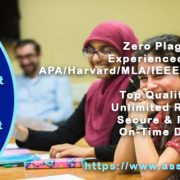Introduction:
The development of international business has not only facilitated a progressive route for large corporations to realize trade opportunities in foreign markets but also allowed small firms to impinge a tangible impact on their competitive advantage. However, the promising increase in the transition of companies from domestic arenas to wider global platforms reflects on the requirement of profound implications for international human resource management.
The effective management of international business is profoundly different from the domestic practices that provide reasonable insights into factors such as motivation, conflict, culture, organizational structure, and politics in the internal environment. The following report emphasizes the description of a training program for a fast-food joint company Fastest Food that is based in Melbourne Victoria (Ada, 2014). The organization’s training program would be directed towards achieving the resolution of international human resource management issues in the event of the company’s expansion into China’s and Japan’s capitals Beijing and Tokyo.
The prominent issues that have been identified in the case of international business expansion include conflict between the Australian managers and the employees of China and Japan, motivation strategies, changes in organizational culture, and the conflicts arising out of strategic and structural changes (Arslan & Coskun, 2014). These issues have to be addressed by referring to the change management theories and strategies such as Bolman and Deal’s four distinctive frames including structure, politics, symbol, and human resources. The frames could be used to refine the specific aspects of the business issue alongside reflecting on the causes of issues about the change management initiatives implemented for cross-cultural business expansions.
Trust development and conflict resolution:
The case study of Fastest Food Company suggests that Australian managers have to engage in the management of Chinese and Japanese employees which could lead to the proliferation of various conflicts. The requirement of change is inevitable since the organization’s Australian managers could not adhere to their domestic values in the international market where shared values and beliefs are often perceived as the reason for managerial conflicts. The transition of an Australian firm into the Chinese and Japanese market would require anticipation of the major conflicts that can arise between the managers and employees (Banskota, 2015).
The increasing complexity of the modern work environment has created profound indications towards improving specialization and interdependence of job roles. Thereafter the references to change initiatives have to be aligned with the increasing use of team effort and team-based practices. Hence the a need for apprehending team-based problems such as idea stagnation, free riding, and the improved chances of conflict among team members leading to the depreciation of team effectiveness (Braysher, 2017). The majority of research about change management in the context of international business management refers to the influence of diversity as the profound antecedent of conflict.
The difference in tenure, race, ethnicity, and nationality has been identified as the most probable factor to induce conflicts among team members. The references to the distinct characteristics of team members could prove to be efficient inputs for identifying the notable factors leading to conflicts (Chang, et al., 2014). The focus on the team identification and trust aspects in peers has to be accompanied by an analysis of processes leading to conflict can be assumed as potential measures that can be applied by Australian managers to develop trust. First of all, team identity has to be established profoundly by the organizational construct. Organizational identification refers to the involvement of employees in the organization from the dimensions of affective, evaluative, and cognitive perspectives of an individual employee.
Organizational identification could be considered the primary substrate for developing positive work behaviors and attitudes. Team identification can be associated with the application of social identity theory that considers the implications of employees considering team goals as their objectives (Dyer & Karp, 2013). Identification of team members with their teams is considered effective for the implementation of effort and limitation of conflict due to their perception of organizational success and failure as their interest. Trust is a significant element in the workforce that can be considered as one of the profound antecedents of conflict.
Trust could be examined from three distinct perspectives in the context of the case study of Fastest Food to provide recommendations for improving trust thereby reducing the probability of conflict. The factor of trust could be assumed as a significant variable in the workplace which has been addressed by various research activities. Trust was depicted as the most profound issue identified in the open-ended comments provided by team members and research studies also imply that trust can be explicitly accounted as the foremost impact on group behavior and interpersonal behavior in team dynamics. Secondly, researchers have considered the emphasis of studies about interpersonal trust on vertical trust relationships while the implications of horizontal relationships have been ignored for a long (Dyer & Karp, 2013).
Investments in social capital are generally affected by a lack of research since the development of trust is not only required between organizational levels but also within the levels. The possible implications that can be provided to evaluate trust among peers and the consequences associated with the lack of trust. Other dimensions of research in the context of trust have been aligned with the perception outcomes or performance outcomes.
The impact of trust on workplace attitude has been promisingly observed while referring to the limitations in workplace behavior and performance. This indicates that the inconsistency of efforts to develop trust could be dependent on the complexities arising due to its indirect implementation through group processes (Garcia, 2015).
The role of mediation in the development of trust among team members has also been noted profoundly in research studies. The conventional input-output models have proved to be insufficient on the grounds of negligence for intervention variables. The references to Tuckman’s theory of small group development have proved to be influential in the attempts to address processes of group formation, establishment of relationships, sharing of ideas, and confrontation for addressing the problems.
The examples of studies that have been conducted using the double mediation model refer to the moderation of the effects of team diversity through conflict and trust (Jensen, 2014). These studies provided insights into the resolution of negative impacts that can be rendered by diversity on conflict through increasing the levels of trust. Another noticeable impact of the process of trust development could be noticed in the outcomes of improved group performance alongside the provision of fostering relationships through intragroup conflicts. However, intragroup conflicts have to be managed effectively to prevent negative outcomes that can be profoundly observed in changes in behavioral and workplace attitudes (Jull & Mirenda, 2016).
The establishment of varying levels of analysis in research studies about primary constructs of trust development suggests approaches to team identification from the perspective of a team-level concept. Team identification can be conceptualized with the profound implication towards team identification from the perspective of individual-level variables that would facilitate the perception of a sense of belonging within the team.
The distinct components of the model associated with in-group identification suggest that individual self-stereotyping is a major component that could be associated with developing trust. The individualized perception which is associated with the shaping of the world perspective and the biases harbored by an individual can be considered as team identification. The individual perceptions harbored by individuals about identity perceptions can be associated with the explicit depiction of prominent levels of stability as well as reliable predictions of interpersonal outcomes (Kotru, et al., 2014).
Conflict has been associated with descriptive categories referring to individual, intra-group, and dyadic levels wherein the multilevel model of group conflict can be formidably interpreted as a source. The experience of conflict from the individual phenomenal perspective can be observed profoundly in the affective reaction of employees to incompatibilities and the perception that suggests individual-level conflicts. Intra-group conflicts and dyadic conflicts are formally associated with the manifestation of social media in higher levels of analysis (Malik, et al., 2014).
Therefore formal interpretation of the conflict at varying levels of individual and team perspectives could be derived from the empirical research findings. The formal outcome could be noticed in the impact of an individual’s behavior on the perception of conflict between team and individual. The testing of conflict at the individual level has also suggested that an individual is partially responsible for making the work environment or framing the microenvironment through personal behavior. The observation of antecedents about group-level conflict also suggests the influence of the data obtained from the supervisor’s team ratings which are being supervised by the team as a whole (Onyeozu, Adekola & Nwogu, 2016).
The case of Fastest Food Company suggests the implications for cross-level analysis requirements on behalf of the Australian managers so that they could identify pitfalls arising on individual and group levels by referring primarily to identity theories. The identification of profound aspects of the identity perceptions of Japanese and Chinese employees would enable Australian managers to apprehend the sources of conflict and resolve them effectively through team and individual identity perception (Sweeney, et al., 2014). One of the profound implications that can be drawn from the research studies and theoretical review is directed toward the use of identity theories as promising resources for the development of trust as a plausible initiative for the resolution of conflict.
Leadership Development Plan
In this report, the design plan is developed for the company which is headquartered in Melbourne, Tokyo.
To build trust among the employees internationally with that of the Australian managers the following design plan has to be followed for training the managers to avoid any further conflicts in the company (Thompson & Conkright, 2015).
The leadership development program globally has to take place per the context of the long-term strategy of the company’s fastest food. Once the strategy has been defined, several steps are to be taken care of by the organization. Here is one of the models which can be considered:
- A new mindset has to be created along with awareness among the senior leadership team
- A new culture has to be established as per the requirements and the strategies of the country such as Chinese and Japanese as the organization is located in that place which will help support the creation of leaders globally
- The unique capabilities to be identified are required for the leadership, and management internationally by the manager of the company
- In their careers, the company has to start developing future global leaders
- The development techniques that are established have to be utilized by the company
- For identifying the potential of the global leadership plan the ways in a better way
Creation of new mindsets
The requirements between the CEO of the company Fastest Food located in Australia and the head of human resources have to be a powerful and convincing situation which is created by showing the importance of the investments in leadership development in the branches in Beijing and Tokyo. The top-level management has to analyze the requirements of the future realistically. Once there is an agreement on the requirement they can just start with the development of the talent process (Yang, et al., 2016).
According to the specific needs of the Chinese and Japanese markets, the firm has to penetrate and the needs are to be identified. For managing internationally the Australian managers are to be acknowledged with the demands of the abroad assignments besides providing suggestions for the career for the individuals who ever accept it. In addition to this, the concerns of making serious mistakes are to be acknowledged.
A supportive culture is to be created
In this effort, the creative team has to get committed collectively. It has been announced by one of the CEOs that the talent of the leadership is highly promising and is being owned by the CEO and the company and it will not lead to any division of the company though it is abroad without bringing any cultural conflicts. The distribution of the organization will be for the best of the industry and not just for the betterment of one division.
The new culture that is developed by the fastest food will include the posting of the assignments overseas that is Tokyo and Beijing. It will require volunteers because it has been learned by the organization that those who voluntarily in such kinds of assignments will invariably with the highest frequency. The people who are working in the overseas branches have to be supported by the Australian managers and it has to be identified clearly by them, which the language and the training related to cultural awareness besides the financial incentives are included.
The creation of this new culture and the context will involve identifying the mentors internally in the firm at those abroad branches so that they can provide ongoing counseling to the individuals who are into these assignments of managing leadership. Examining tips for individuals and their families is considered to be the best idea for providing comfort with the potential conditions of living things involved in global projects (Jull & Mirenda, 2016).
The policies of the fastest food in Australia, which will be governing the branches in Tokyo and Beijing, have to be transparent and the managing team has to discuss with the individuals and their families. The length of the period the individuals stay overseas to carry out the project has to be clear so that they can plan accordingly.
Cultural conflicts
It is quite obviously recognized that in whichever culture we grow up it will be shaping our values, our overall view towards the world, and mainly our beliefs. Some of the authors have described it stating that it is the software of the mind. As per theory, analysis it is suggested that there are five distinctive dimensions of culture.
According to their view, it is said that none of the organizations will want its global leaders to attempt adapting the perspectives of culture and the values of that particular country in whichever they are establishing. But it can be expected that they should be aware of the differences and should act accordingly in a respectful manner with the individuals who will possess sharp differences.
Differences in power- The firm has to think that to what extent the culture will be accepting that the power is not distributed evenly. For eliminating the cultural disconnects are they working constantly has to be assessed? In the culture, if the power differential is lower individuals will get comfortable in not agreeing with the leadership team (Elpers, et al., 2017).
Collectivism versus Individualism- To what level do the individuals will look for themselves primarily versus the collective goods has to be checked.
Confidence versus modesty- It has been labeled as masculinity vs. femininity by a few. It refers to the positioning of the competition, cooperation, security, challenge, etc.
Avoidance of uncertainty- It is not to get confused with the avoidance of risk. When it is confronted with uncertainty this quality will describe the cultural feelings of anxiety. It establishes itself in its positioning for seeking the rules that will govern the behavior.
Identify the capabilities that are required
The skills that are required for the global leader are simply the ones that are considered to be proficiency at the highest level for each of the competencies of leadership. But the start is not considered to be correct. Global leaders have to possess some distinctive qualities.
The following are some of the traits that are essential for the global managing team to control the branches abroad:
Character- The individual is often placed in a new environment deprived of any of the supportive structures that have surrounded them typically (Chang, et al., 2014).
Stability- The organization has to find someone who is stable emotionally, can work calmly under pressure, is strong while facing challenges and delays, and can enjoy a rock-solid relationship with all the members of the firm. Flexibility and adaptability are the major things holding the leadership overseas.
Interest- The managing team has to possess an interest in showing leadership skills abroad from the Australian branch. The team has to be self-aware, of the usual requirements and it should be willing to get engaged with the personal development plan which is considered to be the essential requirement for success in the branches internationally can be seen clearly from the willingness to learn regarding the new culture and appreciating it.
Motivation- What is the interesting thing that would motivate an individual? Not every individual will be eager to work in a new country and with a new culture. Identifying the people who have the motivation to work internationally and can take the complexity and challenges can be another factor that can lead to key success.
Tolerance- Working with people of different cultures requires a lot of tolerance levels due to the differences in the approach and the pace. Sometimes there might be inefficiencies that can be out of control. Getting the permits and the licenses from that local government, getting done with the installation of the equipment and even getting the license for the local drivers can be different totally from that of the home country.
Get started at the earliest stages
The training for the managing team has to be started earlier, particularly during their career development so that it will be useful to the firm in case of emergencies and sudden start-up of the company abroad. The development team has to be aware of the local culture, the nature of the individuals, etc., and has to act accordingly for the successful business. The company has to make the strategic perspectives as per the norms of the firm.
These managing executives should have a clear view regarding the future of the company. The relationship with the customers has to be maintained excellently to have the anticipating market and the economic trends (Onyeozu, Adekola & Nwogu, 2016). The team has to look at the view of the longer term of the business and the market in those countries. The company has to make a broad strategy and then convert it into the significant objectives and goals of the firm.
Focus on the customer and their understanding- the global leaders should have the best quality of understanding the customers. They have to understand the problems, needs, and concerns of the customers. For accomplishing the goals and objectives of the customers they have to assist them as partners. A relationship has to be excellently maintained with the customers of those countries as they would trust them and their business.
The proven methods are to be utilized
A variety of learning methods were traditionally used by leadership development programs. The most important ones are case studies, action learning, simulations, discussion groups, lectures, reading assignments, and coaching. Having managing leadership skills globally offers some of the tools for its development. In this, specialized projects on action training that have focussed on global issues are included. Other programs include the development and travel to the locations.
For assessing the potential of global leadership utilize more rigorous methods
For assessing the potential of global leadership there are various instruments which are created. In this, the intercultural effectiveness test, instruments related to multicultural personality, inventories of a global market, and the inventories of global competency are included. There is an evaluation of the complexity of the qualities of the procedure of training (Thompson & Conkright, 2015).
Conclusion
As there is an expansion of the organizations globally there would be the magnification of the effective global leaders as it is the requirement. It is identified from the research and the experimental studies that most organizations lack a clear direction while designing their strategy of development and promoting their leadership skills and the leaders who can take the business to further levels overseas. The awareness has to be created over the issues by focussing on it constantly and support has to be established for the development of the leadership globally. It is considered to be the first step in designing the plan of leadership development. Hence, in the effectiveness of global leaders, the characteristics and the unique competencies have to be identified and have to work accordingly in developing these things early in their careers of the talent pool of the firm with the help of the approach that is proven in identifying the strengths and developing them. By putting these recommendations into practice the organization’s fastest food located in Australia and developing branches in Tokyo and Beijing will be in a better position than expected for the successful expansion of it globally if it is led by the extraordinary global leaders.
References
Ada, A.J., 2014. Conflicts as constraints to effective management of tertiary institutions in Nigeria: the way forward. International Letters of Social and Humanistic Sciences, (14), pp.45-52.
Arslan, A. and Coskun, A., 2014. A Needs Analysis Study for the English Curriculum of the Teaching Staff Training Program in a Turkish University. Modern Journal of Language Teaching Methods, 4(1), p.283.
Banskota, A., 2015. Effective management of plastic waste and other solid waste in Nepal: a case study of Kathmandu valley.
Braysher, M., 2017. Managing Australia’s Pest Animals: A Guide to Strategic Planning and Effective Management. CSIRO PUBLISHING.
Chang, N.A., Grant, P.M., Luther, L. and Beck, A.T., 2014. Effects of a recovery-oriented cognitive therapy training program on inpatient staff attitudes and incidents of seclusion and restraint. Community Mental Health Journal, 50(4), pp.415-421.
Dyer, K. and Karp, R., 2013. A staff-training program to increase spontaneous vocal requests in children with autism. Behavior Analysis in Practice, 6(2), p.42.
Elpers, K., Amano, T., DeCoster, V. and Johnson, M., 2017. Effectiveness of a Psycho-Educational Staff Training Program on Attitudes of Staff in a Long-Term Care Facility: A Pilot Study and Framework. Educational Gerontology, (just-accepted).
Garcia, A.S., 2015. “Speak” As a Method to Drive the New Management Focused On People: Effective Management Tool for Executive.
Jensen, R.W., 2014. Improving software development productivity: Effective leadership and quantitative methods in software management. Pearson Education.
Jull, S. and Mirenda, P., 2016. Effects of a Staff Training Program on Community Instructors’ Ability to Teach Swimming Skills to Children With Autism. Journal of Positive Behavior Interventions, 18(1), pp.29-40.
Kotru, R., Rawal, R.S., Mathur, P.K., Chettri, N., Chaudhari, S.A., Uddin, K., Murthy, M.S.R. and Singh, S., 2014. Effective Management of Transboundary Landscapes-Geospatial Applications. The International Archives of Photogrammetry, Remote Sensing and Spatial Information Sciences, 40(8), p.1309.
Malik, M., Hussain, A., Shafiq, M.A. and Shafie, A.A., 2014. Role of Essential Drug List in Effective Management of Essential Anti Maliaral Drugs in Health Care System of Pakistan Challenges in Policy Development to Practice. Pharmaceut Reg Affairs, 3(120), p.2.
Onyeozu, A.M., Adekola, G. and Nwogu, G.A., 2016. Conscientisation Strategies For Effective Management Of Tourist Attractions Towards Development Of Communities In Imo State, Nigeria. Journal Of Good Governance And Sustainable Development In Africa (JGGSDA), 3(1).
Sweeney, L.A., Warren, O., Gardner, L., Rojek, A. and Lindquist, D.G., 2014. A simulation-based training program improves emergency department staff communication. American Journal of Medical Quality, 29(2), pp.115-123.
Thompson, N. and Conkright, M., 2015. Creating An Innovative Staff Training Program to Meet Mbsaqip Standards for Adolescents on A General Care Pediatric Floor. Surgery for Obesity and Related Diseases, 11(6), pp.S85-S86.
Yang, G.M., Tan, Y.Y., Cheung, Y.B., Lye, W.K., Lim, S.H.A., Ng, W.R., Puchalski, C. and Neo, P.S.H., 2016. Effect of a spiritual care training program for staff on patient outcomes. Palliative & Supportive Care, pp.1-10.










